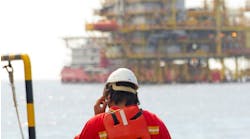A comparison of the two forms of seismic data acquired over the Fuji Prospect, US Gulf of Mexico
John A. Ward
PGS Reservoir
The Fuji Prospect Area in the Green Canyon area of the Gulf of Mexico was selected as an area to test the effectiveness of vertical cable (P Wave) acquisition. The test was conducted jointly among Texaco E&P Technology Department, Texaco Exploration and Production, and PGS Exploration from the summer of 1995 to the fall of 1996. The evaluation had several objectives. One goal was to move methodology and algorithms from an oil company technology group to an active production environment. This included both the acquisition of the vertical cable data and subsequent processing in a massively parallel system. A major scientific aspect of the project was the comparison of a modern towed streamer data set at the same location as a vertical cable data set. Another driving force behind the project was the creation of pre-stack migrated data set for active use by exploration geophysicists. As a result, there were firm project deadlines that minimized opportunities for testing and theoretical evaluation of the data. To both optimize the speed of processing and provide a direct comparison of the towed streamer and vertical cable volumes, both were migrated with the same velocity field derived from towed streamer data. The study area was approximately 350 square kilometers.
PGS Reservoir and PGS Tensor are currently comparing the two data sets, while Texaco is preparing subsurface maps for wellsite selection. The analysis of the data is in a preliminary stage. This report is designed to show examples of lines acquired by each method and provide preliminary observations and conclusions concerning the vertical cable method.
Data Acquisition and Processing
The conventional towed streamer data was acquired with two vessels, each with three cables. Data was acquired with an 80-meter source interval and a 25-meter group interval with far offsets of 6,000 meters. The vessel had two sources that shot alternatively. The direction of shooting for the towed streamer was N-S in the same orientation as the vertical cable. The towed streamer bin dimension of 12.5 by 40 meters was decimated to produce pre-stack migration bins of 37.5 by 40.
Vertical cable data was acquired with a roll and swath pattern using 12 cables in a 4 by 3 pattern. There were three vertical cables with a spacing of 1800 meters north south, and four cables 1600 meters apart east west. Each vertical cable at Fuji had sixteen hydrophones with a separation of 150 feet. The bottom phone was near the seafloor. The data was recorded into a buoy on magnetic tape. Shooting started in the southwest corner of the survey with nine cables live with a swath oriented north south between cable columns one and two. The inline spacing was 40 meters with a 3,600 meter tail on each line. The second swath had 12 cables live with a similar shooting swath between columns two and three. Subsequent swaths were acquired by moving the first column of cables into a new position at the front of the swath. This pattern of shooting continued for ten swaths. A roll is a repeat of the operation starting in a position north of the most eastern cable and moving in the east-west direction. The data sets contains 10 swaths and three rolls for a total of 99 cable locations. The bin dimensions of the vertical cable data are 25 by 40 meters.
Data processing of the two data sets was designed to be as equivalent as possible given the differences in acquisition method and availability of algorithms. Significantly, both data sets were processed through pre-stack depth migration. The seismic profiles compared in this paper are plotted in depth.
Data Examples
The amplitude spectra of the two data sets are compared over the same geologic interval covering the prospective zone at a two way travel time between four and six seconds. Given the similar processing flows, the spectra are nearly alike with the possibility that the vertical cable has greater amplitude per frequency between 22 and 32 hz.
The character of the traces and the lateral change in amplitude of the two data sets were examined visually. To remove some inherent differences in the two data volumes, the output traces were "post stack" processed. A deconvolution was applied to make the spectra more similar and a long window (two second) fixed scalar was applied to equalize the gain. A constant phase shift was applied to the vertical cable data set based on a two second gate to remove gross differences in trace character. Both data sets were filtered with a common bandpass filter.
Visual comparison shows that the termination of high negative amplitude events (a) occurs at a similar position in both lateral position and depth on the two data sets. Similarly, the trace character of the two data sets locally (b) shows a nearly precise match in shape. There are, however, local differences in the two data sets. For example, the amplitude near trough event ( c) increases in amplitude strength in the downdip direction on vertical cable data, but decreases downdip on the towed streamer data. There are also locations where the data sets yield alternate interpretation. At peak event (d) the vertical cable data suggest a complex pattern of reflection events that is absent on the streamer data.
The quality of the data in steep dip areas was also compared. There are several locations within the survey where the steeply dipping beds either underneath the salt, or up to the salt have increased amplitude and continuity on the vertical cable data. This observation is also on depth slices. While this is an interesting observation, the reason for the apparent improvement in high dip areas is not yet understood, and generalized conclusions are premature.
Conclusions:
This data continues to be studied by PGS and Texaco. Current activity includes reprocessing the vertical cable volume with a velocity model that is based on vertical cables only. Other studies are based on detailed comparison of the traces, and the evaluation of model data.
From the preliminary analysis of the data it is clear that the vertical cable method based on a sparse receiver array and a dense source pattern yields seismic traces that are remarkably similar in amplitude and character to their towed streamer cousins.
While the multi-azimuth geometry of the vertical cable can potentially provide improved illumination in subsalt strata, it remains for future work supported by drilling results and modeling analysis to confirm the fidelity of the method.


